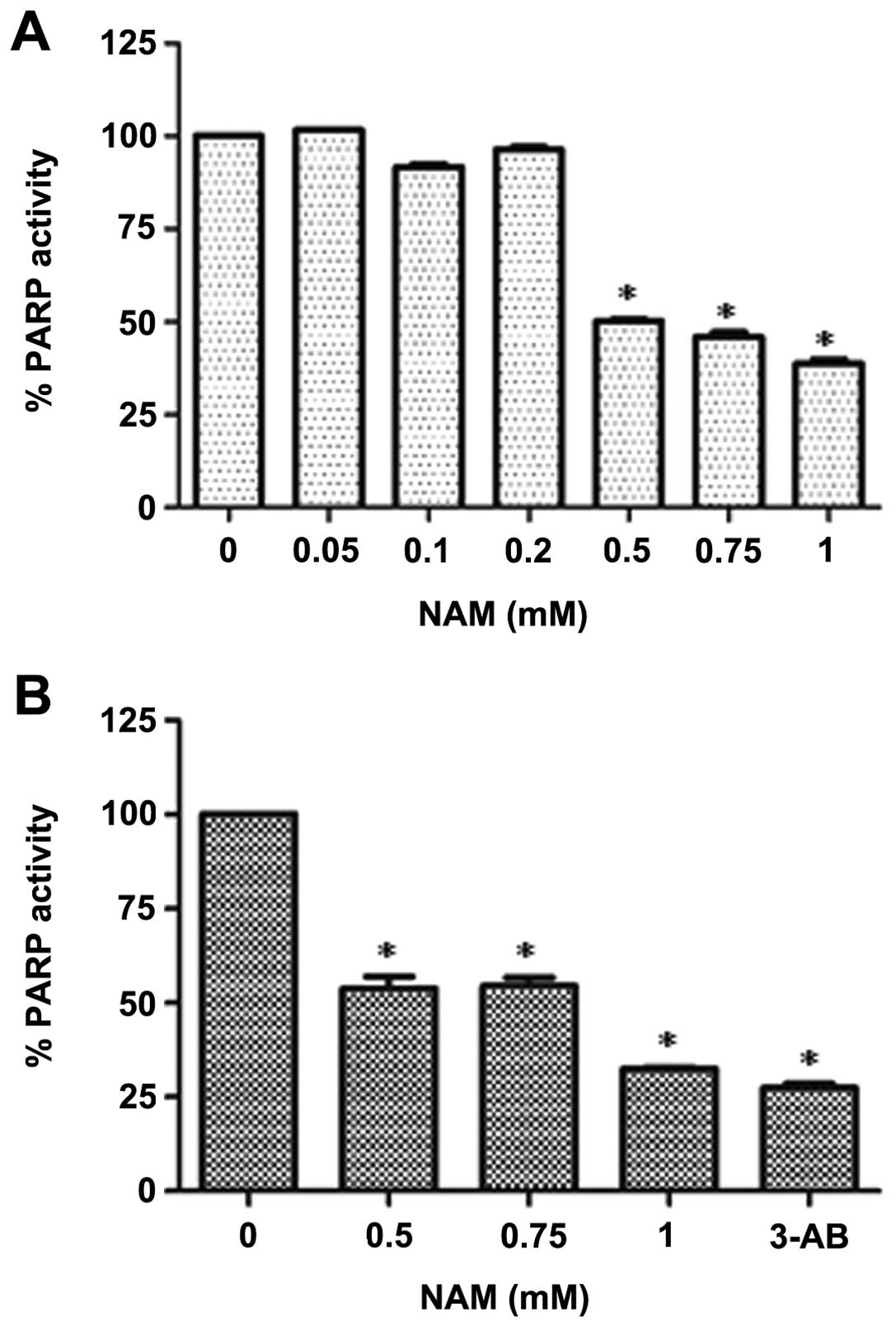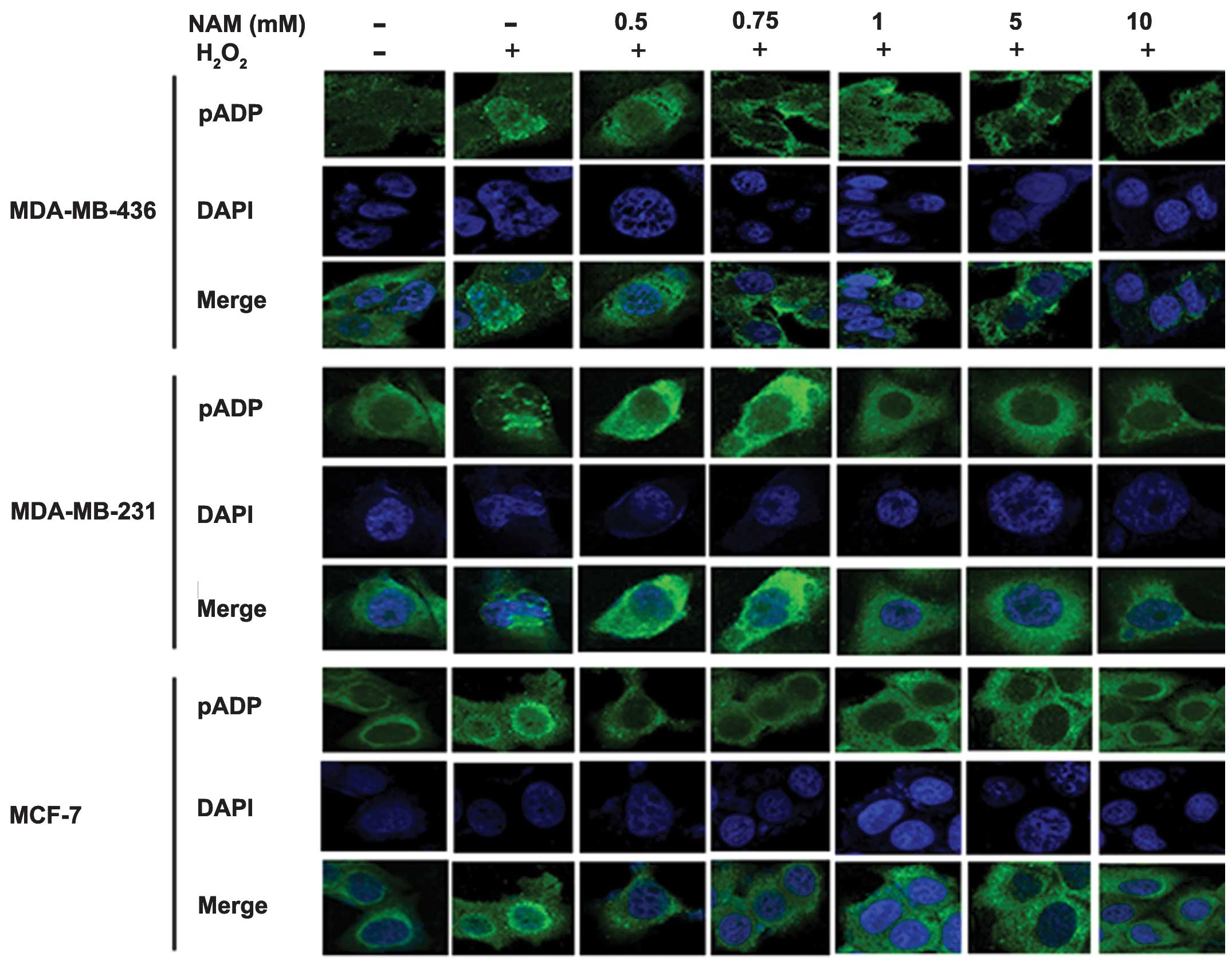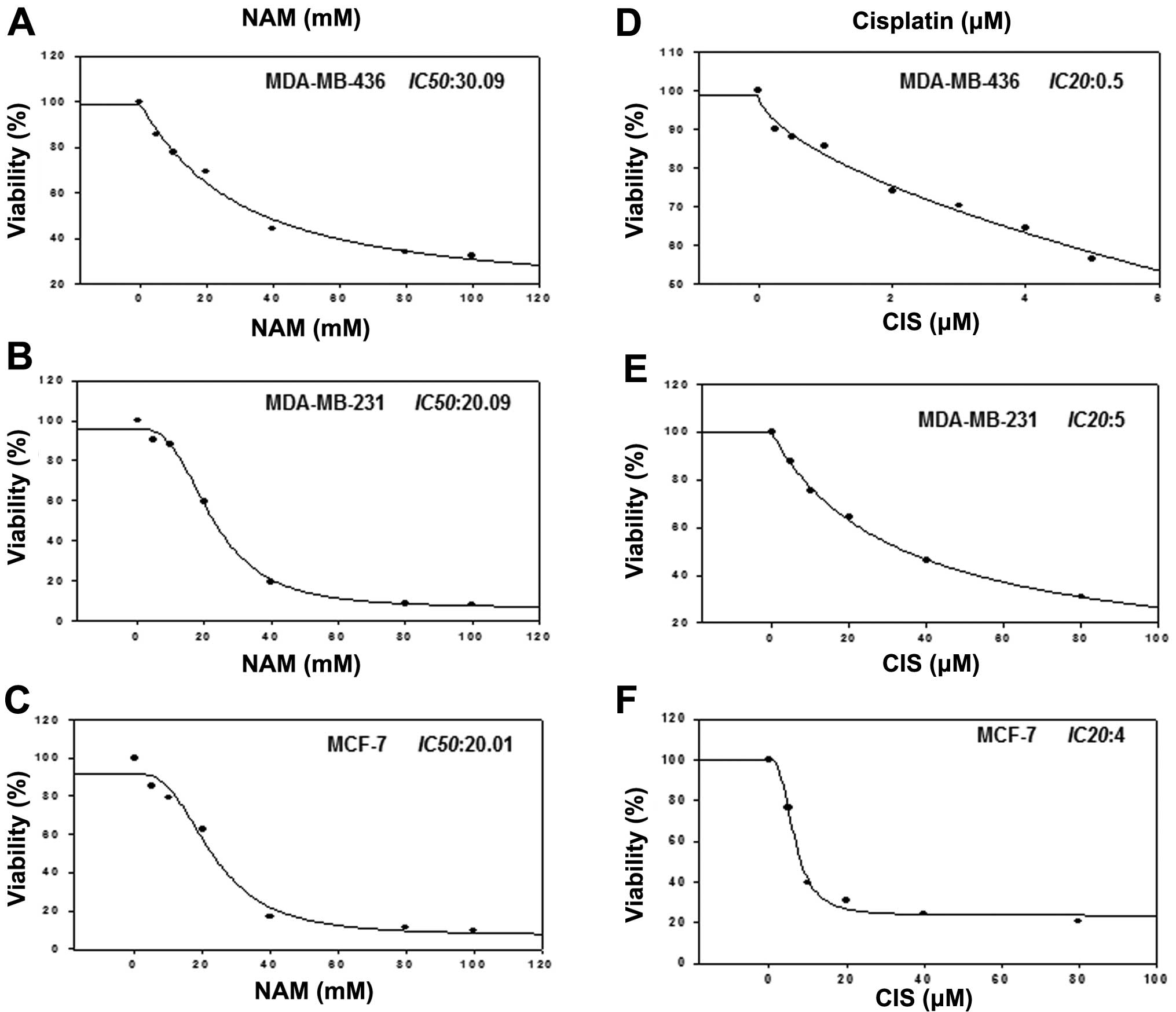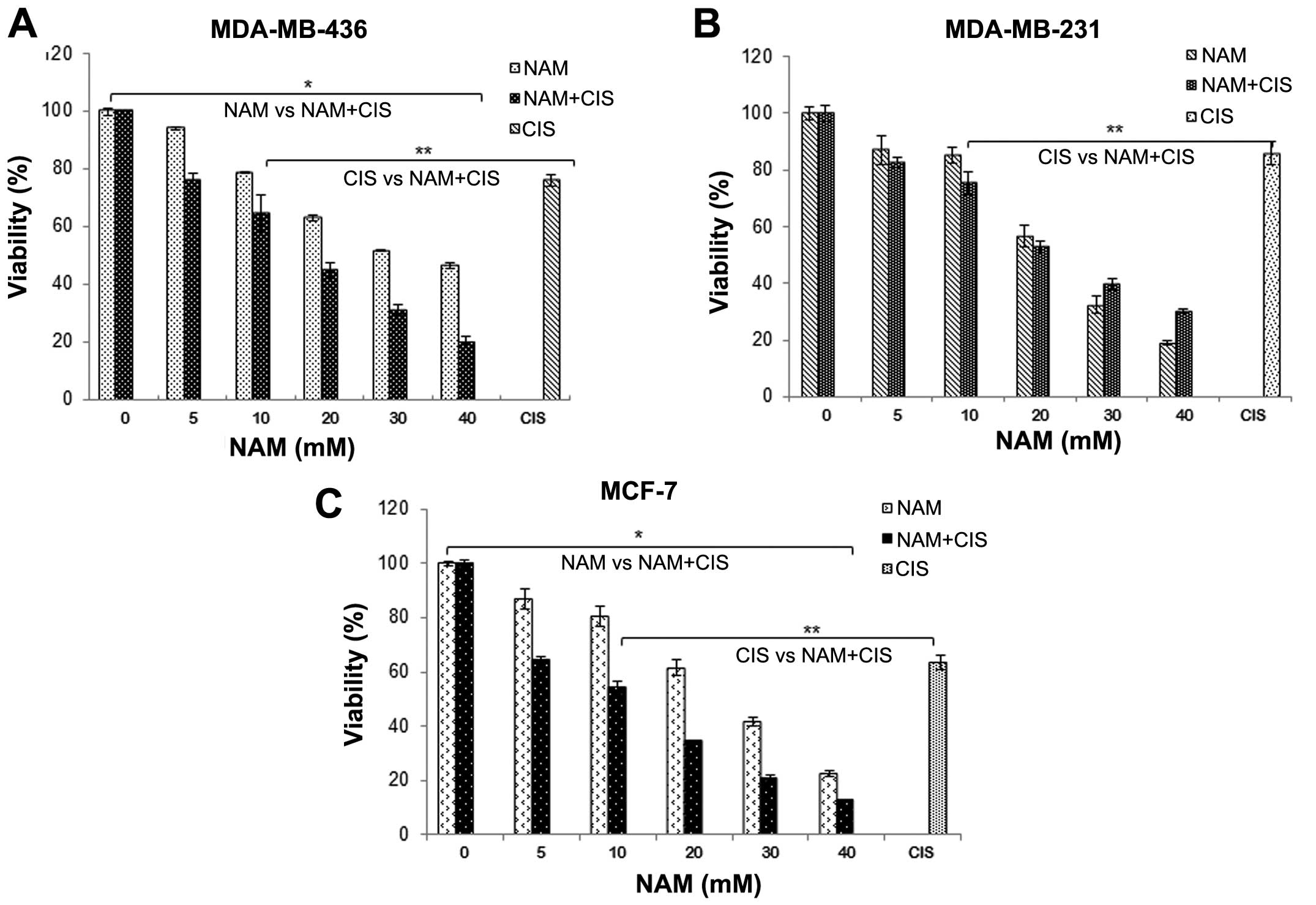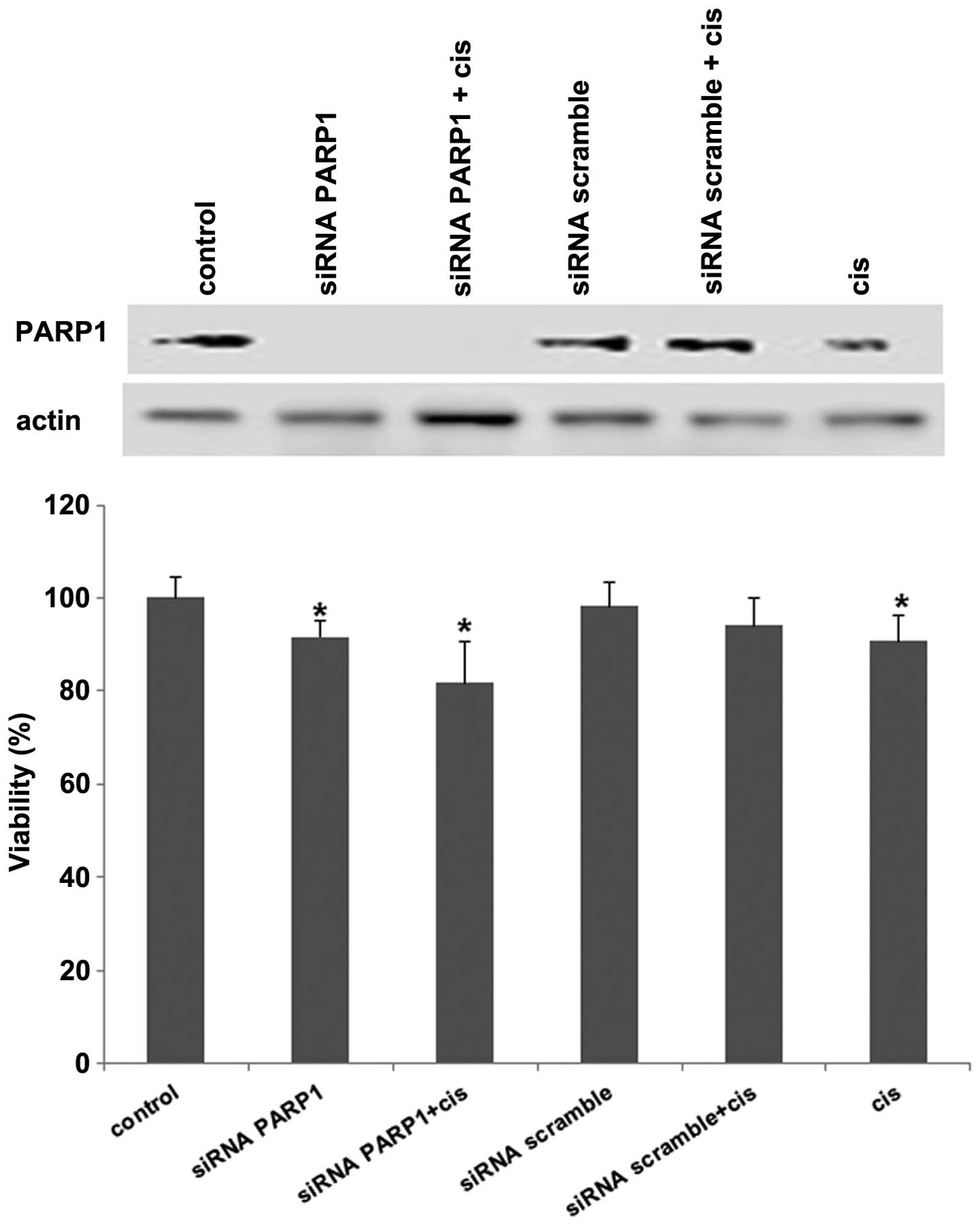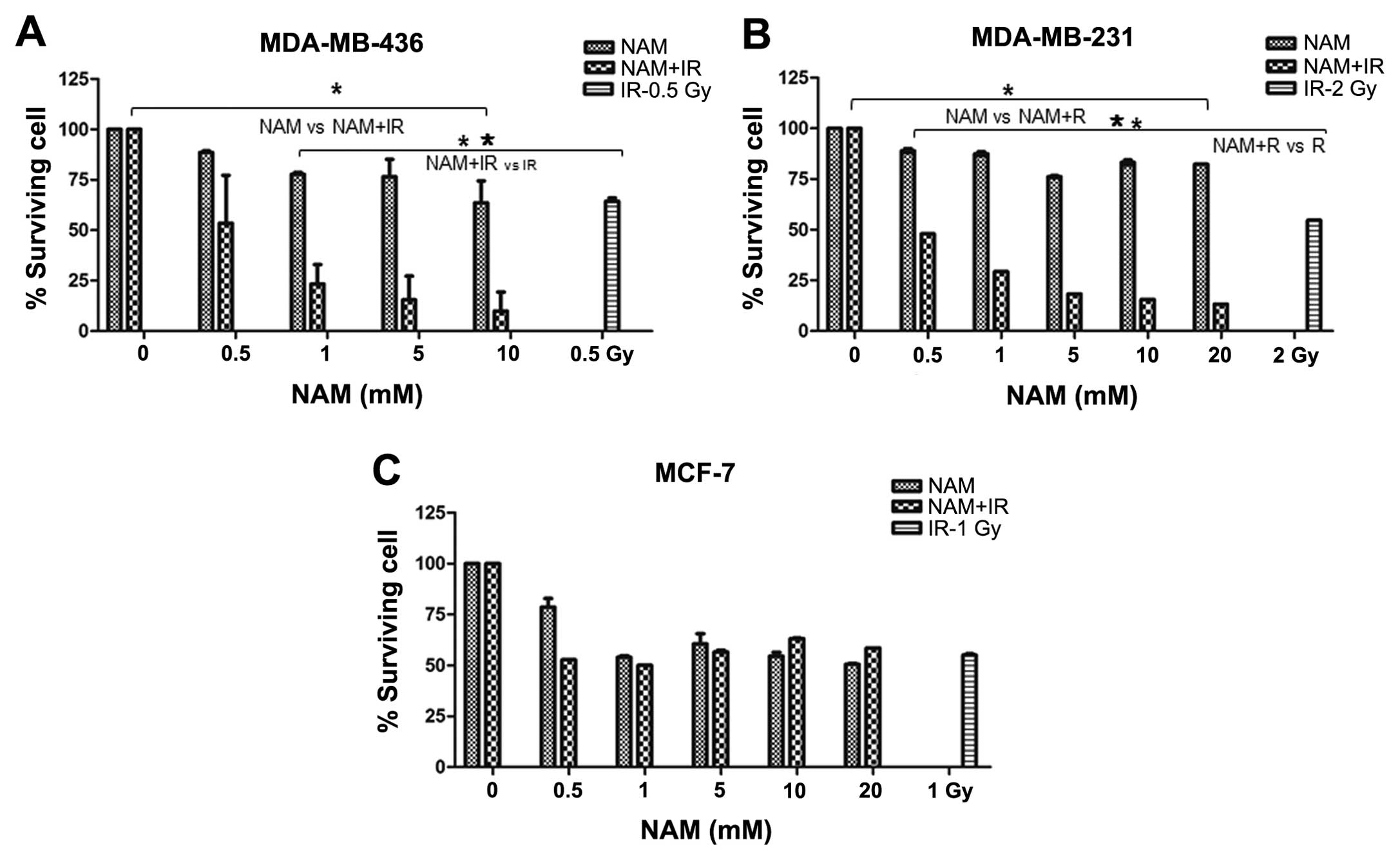Nicotinamide sensitizes human breast cancer cells to the cytotoxic effects of radiation and cisplatin
- Authors:
- Published online on: December 9, 2014 https://doi.org/10.3892/or.2014.3661
- Pages: 721-728
Abstract
Introduction
Poly(ADP-ribose) polymerase (PARP) enzyme inhibitors are emerging as a valuable new drug class in the treatment of cancer. PARP-1 is the founding member of a family of 18 PARP members that have been identified thus far. PARP-1 functions as a key molecule in the repair of DNA single-strand breaks (SSBs) via the base excision DNA repair (BER) pathway (1). Inhibitors of PARP-1 have been shown to enhance the cytotoxic effects of ionizing radiation and DNA-damaging chemotherapeutic agents in vitro and in vivo (2,3). Early preclinical and clinical trial data suggest that PARP inhibitors may be used as chemo/radiotherapy sensitizers and as single agents to selectively kill cancers defective in DNA repair, specifically cancers with germ-line mutations in breast cancer-associated BRCA1 and BRCA2 genes, a strategy known as ‘synthetic lethality’ (4–7). There are currently at least eight PARP inhibitors being developed (8), however, the development of new drugs is extremely costly and there is a gap between the resources invested in drug development and their translatability into longer survival for cancer patients.
Repurposing existing drugs is another strategy for drug development in which safety pharmacology studies have been already done, which reduces the time and cost of approving the compounds for clinical use (9,10). Nicotinamide (NAM; pyridine-3-carboxylic acid) is a water-soluble amide active form of vitamin B3 or niacin. NAM and niacin are precursors for the synthesis of nicotinamide adenine dinucleotide NAD+ and the phosphorylated derivative NADH+ (11). This drug has been used for the treatment of pellagra, diabetes mellitus, acne and schizophrenia and has been shown to have low toxicity even at high doses (12). NAM was identified as the first inhibitor of PARP, while the majority of PARP inhibitors contain the NAM pharmacophore (13). Preclinical studies have shown that NAM may exert antitumor effects and reverse chemotherapy resistance in some models (14). In addition, this drug is currently used as a component of accelerated radiotherapy with carbogen and nicotinamide (ARCON), a therapeutic strategy used in non-small cell lung cancer, head and neck and bladder cancer (15–18). In the present study, the results showed that NAM increased the cytotoxic effects of cisplatin and radiation on breast cancer cells.
Materials and methods
Cell lines
The MDA-MB-436, MDA-MB-231 and MCF7 human breast cancer cell lines were obtained from the American Type Culture Collection (ATCC, Rockville, MD, USA). MDA-MB-436 cells harbor 5396+1G > A (spliced donor site of exon 20), a BRCA1 mutation. MCF-7 and MDA-MB-231 cells express wild-type BRCA1 while MDA-MB-231 cells are hemizygous for BRCA1, with loss of one allele and the remaining non-mutated allele containing two non-pathogenic single-nucleotide polymorphisms. The cell lines were cultured in DMEM/F-12 medium, 10% fetal bovine serum, penicillin (100 U/ml), and streptomycin (1.0 mg/ml) at 37°C in a humidified atmosphere of 5% CO2 and 95% air.
PARP activity assay
PARP activity in vitro was assayed using the Trevigen Universal Chemiluminescent PARP assay kit (Trevigen Inc., Gaithersburg, MD, USA) according to the manufacturer’s instructions. Recombinant PARP was incubated for 1 h with different NAM doses (0.05, 0.1, 0.2, 0.5, 0.75 and 1 mM) in the presence of activated DNA. Chemiluminescent detection was performed as per the manufacturer’s instructions. To assay endogenous PARP activity, cells were grown in a 25-cm2 cell culture flask in medium alone or with NAM for 72 h. The cells were washed once with ice-cold PBS, lysed in 50 μl of PARP buffer containing 0.5 mol/l NaCl, 1% (v/v) NP-40, and protease inhibitors (Sigma-Aldrich, St. Louis, MO, USA) on ice for 30 min with occasional vortexing. The lysates were clarified by centrifugation at 14,000 rpm, at 4°C for 10 min. The protein concentration of the extracts was determined using the Bradford protein dye reagent (Bio-Rad, Hercules, CA, USA), and PARP activity was assayed using the Trevigen Universal Chemiluminescent PARP assay kit according to the manufacturer’s instructions, with modifications. The lysate (30 μg/well) was added in duplicate to wells containing PARP buffer and PARP cocktail, followed by incubation at room temperature for 1 h with NAM at concentrations of 0.5, 0.75 and 1 mM. Activated DNA was added to the standards but was omitted from the extracts. The plate was washed three times with PBS and three times with PBS and 0.1% Triton X-100, followed by incubation with streptavidin horseradish peroxidase (1:1,000 dilution) in diluent buffer for 1 h. The plate was washed again three times with PBS alone and three times with PBS and 0.1% Triton X-100. Chemiluminescent detection was performed as per the manufacturer’s instructions. The background reading was subtracted from the readings of the samples, and PARP activity was calculated using the standard curve obtained from readings of the standards.
Immunofluorescence
The MCF-7, MDA-MB-436 and MDA-MB-231 cells were grown in chamber slides (Sigma-Aldrich) at a 70% of confluence. Immunostaining for poly (ADP-ribose) (PAR) was performed on cells fixed in ice-cold 4% paraformaldehyde in PBS for 10 min. The cells were fixed 1 h after treatment with NAM at concentrations of 0.5, 1, 5 and 10 mM and exposed to H2O2 (1 mmol/l, 10 min, 37°C). Controls were treated with medium alone. The primary antibody used was anti-pADPR (H10, Santa Cruz Biotechnology, Inc., Santa Cruz, CA, USA). Poly ADP-ribosylation immunostaining was developed following NAM treatment. The secondary antibody used was the Alexa Fluor 488-conjugated goat anti-mouse IgG antibody (Molecular Probes, Life Technologies, Carlsbad, CA, USA). Nuclear counterstaining with DAPI was performed after removal of excess secondary antibody. Immunostaining was visualized with a Carl Zeiss confocal multiphotonic laser microscope 780 NLO (Hamburg, Germany).
Cell viability assay
Cell viability was assessed by crystal violet staining. Semi-confluent culture flasks were trypsinized and 2.5×104 cells were seeded in 12-well plates. After 24 h, the cells were exposed to NAM (5, 10, 20, 40, 60, 80 and 100 mM) and cisplatin (20, 40, 60 and 80 μM) at the indicated concentrations. After 72 h, the cells were rinsed with PBS, fixed in 2% formaldehyde for 5 min and stained with 1% crystal violet. Relative cell viability was obtained by scanning with an ELISA plate reader at 540 nm.
Data analysis of drug combination
Synergism or additivity was determined by calculating the combination index (CI) using the equation: CIx = (D1/Dx1) + (D2/Dx2) + a(D1)(D2)/(Dx1)(Dx2), where CIx is the CI value for x% effect, Dx1 and Dx2 are the doses of agents 1 and 2 required to exert x% effect alone, and D1 and D2 are the doses of agents 1 and 2 that elicit the same x% effect in combination with the other agent, respectively. The factor indicates the type of interaction: a =0 for mutually exclusive drugs (similar mechanisms of action), and a =1 for mutually non-exclusive drugs (independent modes of action), with the equation being resolved for a =1. A CI of 1 indicates additivity, a CI of <1 synergism and a CI of >1 antagonism.
siRNA transfection assay
Cells were seeded in 12-well plates Nunc (Thermo Scientific™ Nunclon, Waltham, MA, USA) at 15×103 cells/well into 0.5 ml of Optimem (Applied Biosystems Life Technologies, Carlsbad, CA, USA). After 24 h, the cells were transfected with lipofectamine and PARP1 siRNA (cat no. 4390824; Ambrion, Minneapolis, MN, USA) or RNAiMAX containing siRNA Scramble (cat no. 4390844; Ambrion). Cisplatin was added for 24 h and the cells were cultured at 37°C in humidified atmosphere containing 5% CO2. After 72 h, the medium was aspirated and the cells were processed for western blotting and cell viability.
Radiation and drug treatment
Ionizing radiation (IR) of cells was performed at room temperature in culture medium, using a Theratron Phoenix (60Co) irradiator (Best Theratronics Ltd., Ottawa, Ontario, Canada) with an average energy of 1.25 MeV in a field of 20×20 cm2, to a distance isocenter of 80 cm. Cell lines were irradiated at a range of 0.5–6 Gy in the presence of different concentrations of NAM (0.5–20 mM). Control cells were treated with medium only.
Clonogenic assay
Exponentially proliferating cells were plated into a 25-cm2 cell culture flask and incubated for 48 h to allow cells to reach their optimum proliferation rate. NAM (0.5, 1, 5, 10 and 20 mM) was added to the dishes and incubated for 72 h and the cells were irradiated. Control cells were not treated. Cells were collected and cultured in drug-free medium in 60 mm Petri dishes for up to 21 days, depending on the proliferation rate of the individual cell line. Colonies were fixed in methanol and acetic acid (3:1 v/v), stained with crystal violet and counted with a stereoscopic microscopy [Leica Microsystems, (Schweiz) AG, Heerbrugg, Switzerland]. Data are expressed as the percentage of colonies in NAM-treated cultures compared with control cultures. Lethal concentration 50 (LC50) was calculated for each cell line in each independent experiment. Each assay was performed in triplicate for each concentration. Plating efficiencies and the surviving fractions were calculated.
Statistical analysis
Data are expressed as the mean ± SD values. For statistical analysis the ANOVA and Bonferroni post-tests were used to mediate GraphPad Prism 5. P<0.05 was considered to indicate a statistically significant difference.
Results
Nicotinamide decreases PARP activity
To examine whether NAM can inhibit PARP activity in vitro, a cell-free PARP activity assay was performed. Recombinant PARP was incubated for 1 h at different concentrations of NAM (50, 100, 200, 500, 750, and 1,000 μM). A significant dose-dependent decrease of PARP activity, starting at 500 μM was observed (Fig. 1A). We also examined whether NAM similarly inhibits PARP cell activity in MDA-MB-436 breast cancer cells deficient in BRCA1. Whole-cell lysates were incubated in the presence of nicotinamide adenine dinucleotide NAD+ and a conjugated histone acceptor protein, and in the absence of activated DNA, allowing us to determine already activated PARP. A significant decrease in PARP activity was observed (Fig. 1B).
Nicotinamide reduces poly ADP-ribosylation in the presence of DNA damage
To confirm that NAM inhibits poly-ADP-ribosylation, we induced DNA damage with H2O2 (10 mmol/l for 10 min) leading to poly-ADP ribosylation in the three cell lines after treatment with 0.5, 0.75, 1, 5 and 10 mM of NAM. We performed a series of immunofluorescent stainings using anti-pADPR. Fig. 2 shows that poly-ADP ribosylation was detected in the nuclei of cells treated with H2O2. Its effect was reduced as a consequence of NAM treatment in a dose-dependent manner.
Growth inhibition by nicotinamide and cisplatin
To determine whether PARP inhibition with NAM sensitizes cell to cisplatin-induced death, we treated MDA-MB-436, MDA-MB-231 and MCF-7 cell lines with cisplatin (0–100 μM) and NAM (5, 10, 20, 40, 60, 80 and 100 mM) and determined the IC50 value. Fig. 3A–C shows the IC50 value for NAM in each cell line (20–30 mM). On the other hand, because it has been reported that deficient BRCA1 cells are more sensitive to agents that induce DNA damage, we analyzed the effect of cisplatin in three cell lines to obtain the IC20 value through a dose response curve. The results demonstrated that MDA-MB-436 cells (Fig. 3D–F), deficient of BRCA1 were more sensitive than MDA-MB-231 and MCF-7 cells.
Nicotinamide sensitizes breast cancer cells to cisplatin toxicity
We also analyzed the effect of co-treatment of NAM and cisplatin using a lower dose of cisplatin (IC20) and varying doses of NAM (5, 10, 20 and 40 mM). The results demonstrated that a combination of NAM and cisplatin significantly decreased the viability of MDA-MB-436 and MCF-7 cells as compared to NAM alone (P<0.001, Fig. 4A and C), while MDA-MB-231 cells showed no significant differences (Fig. 4B). On the other hand, when comparing the effect of NAM and cisplatin on the viability of breast cancer cells, we observed a significantly higher decrease compared to cisplatin alone (P<0.001). To verify these results we determined the CI (combination index) using the median-effect method which revealed a clear synergistic interaction between NAM and cisplatin (CI <1) in MDA-MB-436 and MCF-7 cells (Table I), whereas MDA-MB-231 cells failed to show a synergistic interaction.
Growth inhibition by PARP1 knockdown is increased by cisplatin
To determine to what extent the downregulation of PARP1 inhibited cell growth, MDA-MB-436 were subjected to siRNA against PARP1. The results showed that at 72 h there was complete knockdown of mRNA of PARP1 and cell growth was inhibited by 10%. When cisplatin was added this inhibition increased as compared to cisplatin alone or PARP1 inhbition. These differences were statistically significant. No growth effects were observed for scramble siRNA with or without cisplatin (Fig. 5).
Radiosensitivity in breast cancer cells by nicotinamide
The effect of NAM in combination with ionizing radiation (IR) through clonogenic assay was analyzed to determine the colony-forming ability from a cell after inducing DNA damage. Survival curves were performed to determine the median lethal doses (LD50), which were defined as the absorbed dose of ionizing radiation (Gy) required to induce 50% cell death. The results demonstrated a different sensitivity to IR in cell lines. MDA-MB-436 cells were more sensitive to IR than MDA-MB-231 and MCF-7 cells (data not shown). Subsequently, we analyzed the effect of NAM combined with IR. A significant decrease in cell survival levels in MDA-MB-436 and MDA-MB-231 cells exposed to the combination compared with NAM only was observed (P<0.001, Fig. 6A and B), while MCF-7 cells showed no significant differences (P<0.001, Fig. 6C). When comparing the effect of the combination of NAM and IR versus IR only, we observed a significant effect on survival (P<0.001, Fig. 6A and B), while MCF-7 cells showed no significant difference (P<0.001, Fig. 6C).
Discussion
The results of this study show that NAM inhibits the growth of breast cancer cell lines in a dose-dependent manner. In addition, depletion of PARP1 mRNA reduces cell viability and NAM increases the cytotoxic effects of cisplatin and induces radiosensitization to various degrees in MDA-MB-436, MDA-MB-231 and MCF-7 breast cancer cell lines.
A number of PARP inhibitors are being developed in the clinic as single agents and/or in combination with other drugs as potential enhancers of DNA-damaging cytotoxic agents, such as alkylating agents or radiation therapy. The chemistry of most of these agents is that of reversible NAD+ mimetics, although they have different bioavailability and molar equivalence for PARP enzyme inhibition (1,8). Nevertheless, cancer drug development needs alternative approaches for drug identification because of increasing failure rates, high cost, poor safety, limited efficacy, and a lengthy design and testing process of new entities. In this sense, drug repurposing of established non-cancer drugs that have anticancer activity provides an opportunity to rapidly advance therapeutic strategies in clinical trials (9,10).
Despite the long-established activity of NAM as a PARP1 inhibitor this drug has not been extensively evaluated as anticancer agent. However, it has largely been used in the clinic at pharmacological doses over many years with a low incidence of side effects and toxicity for diverse conditions including dermatological, metabolic and psychiatric disorders (19–22). In cancer, NAM has been used in clinical studies in combination with accelerated radiotherapy with carbogen and nicotinamide (ARCON) for radiosensitation (12,16–18). In the present study, we demonstrate that NAM effectively inhibits PARP activity in vitro, results that are consistent with those of previous reports (13). In addition, we show that NAM inhibits endogenous PARP activity in extracts from BRCA1-deficient MDA-MB-436 cells. PARP is important in DNA repair, and our results showed that NAM inhibits ADP-ribosylation in the presence of DNA damage induced by H2O2 in a dose-dependent manner in the three breast carcinoma cell lines examined, suggesting that NAM blocks DNA repair through PARP-1 inhibition. This effect is observed in the three breast cancer lines, indicating that its action is independent of the BRCA1 status. We analyzed whether inhibition of PARP induced by NAM or knockdown of PARP1 mRNA may have an effect on cell viability, demonstrating that both experimental conditions reduce cell viability.
It has been reported that PARP inhibition may potentiate the effects of antineoplastic DNA-damaging agents such as temozolomide, cyclophosphamide and platinum in BRCA1-deficient cells (23). Similarly, AZD2281, another PARP inhibitor, in combination with cisplatin synergistically induced cell growth inhibition of breast cancer cells deficient in BRCA2 (24). In agreement with findings of that report, our results demonstrate that the combination of NAM with cisplatin significantly decreased cell viability in the three breast cancer cell lines regardless of the BRCA1 status. Thus, NAM induces synthetic lethality in BRCA1-deficient breast cancer cells as is the case for other PARP inhibitors.
Inhibition of PARP activity reduced the single-strand breaks (SSBs) repair range and increased sensitivity to ionizing radiation and antineoplastic agents. As such, PARP inhibition exerts radiosensitization by facilitating the conversion of an unrepaired SSB to double-strand breaks (DSBs) during the S phase of the cell cycle (25). Our results demonstrate a radiosensitizing effect of NAM (0.5 Gy) in cells deficient of BRCA1 (MDA-MB-436) and p53 (MDA-MB-231), compared to MCF-7 cells. In agreement with our results, it was previously reported that MCF-7 cells exhibit resistance to cell death induced by ionizing radiation caused by lack of caspase-3 activity (26).
The results of the siRNA demonstrate that depletion of PARP1 has only a modest effect on reducing cell viability. However, it is known that NAM exerts a number of biological actions including inhibition of SIRT1 (silent mating-type information regulation 2, homolog 1), which is a NAD+-dependent deacetylase that regulates the processes of stress response and cell survival (23). Studies have shown that SIRT1 inhibition by NAM decreases the viability of MCF-7 cells by inducing apoptosis through the activation of caspases (27) as well as growth inhibition and chemosensitization to gemcitabine in pancreatic cells (28).
Our findings and those of other studies on the antitumor effects of NAM in a number of cancer models suggest that this drug that can be clinically tested as a repositioned cancer drug. A major drawback for its potential application is that the antitumor effects of NAM require drug concentrations in millimolar ranges (>10 mM) when used as single agent. However, when used for radiosensitization or in combination with cytotoxic drugs, the effects are seen at lower molar concentrations. Pharmacokinetic studies in cancer patients receiving oral high-dose NAM show that at doses of 6 g daily, peak plasma concentrations can be as high as >200 μg/ml, which corresponds to molar concentrations >2 mM. No clinical significant toxicity other than easily controlled nausea and vomiting were observed (29–31). In summary, further investigation on NAM is required to evaluate its activity in other tumor models as well as to demonstrate whether it increases the efficacy of combined chemoradiation.
Acknowledgements
The authors would like to thank Dr Patricia García López for valuable comments concerning this study as well as M.C. Roberto Lazzarini for technical assistance. This study was supported by CONACYT Mexico grant (203457).
References
|
Davar D, Beumer JH, Hamieh L and Tawbi H: Role of PARP inhibitors in cancer biology and therapy. Curr Med Chem. 19:3907–3921. 2012. View Article : Google Scholar : PubMed/NCBI | |
|
Hirai T, Shirai H, Fujimori H, Okayasu R, Sasai K and Masutani M: Radiosensitization effect of poly(ADP-ribose) polymerase inhibition in cells exposed to low and high liner energy transfer radiation. Cancer Sci. 103:1045–1050. 2012. View Article : Google Scholar : PubMed/NCBI | |
|
Michels J, Vitale I, Senovilla L, et al: Synergistic interaction between cisplatin and PARP inhibitors in non-small cell lung cancer. Cell Cycle. 12:877–883. 2013. View Article : Google Scholar : PubMed/NCBI | |
|
De Soto JA, Wang X, Tominaga Y, et al: The inhibition and treatment of breast cancer with poly (ADP-ribose) polymerase (PARP-1) inhibitors. Int J Biol Sci. 2:179–185. 2006. View Article : Google Scholar : PubMed/NCBI | |
|
Bryant HE, Schultz N, Thomas HD, et al: Specific killing of BRCA2-deficient tumours with inhibitors of poly(ADP-ribose) polymerase. Nature. 434:913–917. 2005. View Article : Google Scholar : PubMed/NCBI | |
|
Farmer H, McCabe N, Lord CJ, et al: Targeting the DNA repair defect in BRCA mutant cells as a therapeutic strategy. Nature. 434:917–921. 2005. View Article : Google Scholar : PubMed/NCBI | |
|
Murphy CG and Moynahan ME: BRCA gene structure and function in tumor suppression: a repair-centric perspective. Cancer J. 16:39–47. 2010. View Article : Google Scholar : PubMed/NCBI | |
|
Hilton JF, Hadfield MJ, Tran MT and Shapiro GI: Poly(ADP-ribose) polymerase inhibitors as cancer therapy. Front Biosci. 1:1392–1406. 2013. View Article : Google Scholar | |
|
Gupta SC, Sung B, Prasad S, Webb LJ and Aggarwal BB: Cancer drug discovery by repurposing: teaching new tricks to old dogs. Trends Pharmacol Sci. 34:508–157. 2013. View Article : Google Scholar : PubMed/NCBI | |
|
Dueñas-González A, García-López P, Herrera LA, Medina-Franco JL, González-Fierro A and Candelaria M: The prince and the pauper. A tale of anticancer targeted agents. Mol Cancer. 7:822008. View Article : Google Scholar : PubMed/NCBI | |
|
Surjana D, Halliday GM and Damian DL: Role of nicotinamide in DNA damage, mutagenesis, and DNA repair. J Nucleic Acids. 2010:pii: 157591. 2010. View Article : Google Scholar : PubMed/NCBI | |
|
Knip M, Douek IF, Moore WP, et al: European Nicotinamide Diabetes Intervention Trial Group Safety of high-dose nicotinamide: a review. Diabetologia. 43:1337–1345. 2000. View Article : Google Scholar : PubMed/NCBI | |
|
Virag L and Szabo C: The therapeutic potential of poly(ADP-ribose) polymerase inhibitors. Pharmacol Rev. 54:375–342. 2002. View Article : Google Scholar : PubMed/NCBI | |
|
Chen G and Zeller WJ: Reversal of acquired cisplatin resistance by nicotinamide in vitro and in vivo. Cancer Chemother Pharmacol. 3:157–162. 1993. View Article : Google Scholar | |
|
Kaanders JH, Bussink J and Van der Kogel AJ: ARCON: a novel biology-based approach in radiotherapy. Lancet Oncol. 3:728–737. 2002. View Article : Google Scholar : PubMed/NCBI | |
|
Janssens GO, Rademakers SE, Terhaard CH, et al: Accelerated radiotherapy with carbogen and nicotinamide for laryngeal cancer: results of a phase III randomized trial. J Clin Oncol. 30:1777–1783. 2012. View Article : Google Scholar : PubMed/NCBI | |
|
Bernier J, Denekamp J, Rojas A, et al: ARCON: accelerated radiotherapy with carbogen and nicotinamide in head and neck squamous cell carcinomas. The experience of the Co-operative group of radiotherapy of the european organization for research and treatment of cancer (EORTC). Radiother Oncol. 55:111–119. 2000. View Article : Google Scholar : PubMed/NCBI | |
|
Bernier J, Denekamp J, Rojas A, et al: ARCON: accelerated radiotherapy with carbogen and nicotinamide in non-small cell lung cancer: a phase I/II study by the EORTC. Radiother Oncol. 52:149–56. 1999. View Article : Google Scholar : PubMed/NCBI | |
|
Handfield-Jones S, Jones SK and Peachey RD: Nicotinamide treatment in diabetes. Br J Dermatol. 116:2771987. View Article : Google Scholar : PubMed/NCBI | |
|
Niren NM: Pharmacologic doses of nicotinamide in the treatment of inflammatory skin conditions: a review. Cutis. 77(1 Suppl): 11–16. 2006.PubMed/NCBI | |
|
Kolb H and Burkart V: Nicotinamide in type 1 diabetes. Mechanism of action revisited. Diabetes Care. 22(Suppl 2): B16–B20. 1999.PubMed/NCBI | |
|
Vallely JF, Lovegrove TD and Hobbs GE: Nicotinic acid and nicotinamide in the treatment of chronic schizophrenia. Can Psychiatr Assoc J. 16:433–435. 1971.PubMed/NCBI | |
|
Jung-Hynes B, Nihal M, Zhong W and Ahmad N: Role of sirtuin histone deacetylase SIRT1 in prostate cancer. A target for prostate cancer management via its inhibition? J Biol Chem. 284:3823–3832. 2009. View Article : Google Scholar : | |
|
Audrito V, Vaisitti T, Rossi D, et al: Nicotinamide blocks proliferation and induces apoptosis of chronic lymphocytic leukemia cells through activation of the p53/miR-34a/SIRT1 tumor suppressor network. Cancer Res. 71:4473–4483. 2011. View Article : Google Scholar : PubMed/NCBI | |
|
Evers B, Drost R, Schut E, et al: Selective inhibition of BRCA2-deficient mammary tumor cell growth by AZD2281 and cisplatin. Clin Cancer Res. 14:3916–3925. 2008. View Article : Google Scholar : PubMed/NCBI | |
|
Löser DA, Shibata A, Shibata AK, Woodbine LJ, Jeggo PA and Chalmers AJ: Sensitization to radiation and alkylating agents by inhibitors of poly(ADP-ribose) polymerase is enhanced in cells deficient in DNA double-strand break repair. Mol Cancer Ther. 9:1775–1787. 2010. View Article : Google Scholar : PubMed/NCBI | |
|
Wang T, Cui H, Ma N and Jiang Y: Nicotinamide-mediated inhibition of SIRT1 deacetylase is associated with the viability of cancer cells exposed to antitumor agents and apoptosis. Oncol Lett. 6:600–604. 2013.PubMed/NCBI | |
|
Gong DJ, Zhang JM, Yu M, Zhuang B and Guo QQ: Inhibition of SIRT1 combined with gemcitabine therapy for pancreatic carcinoma. Clin Interv Aging. 8:889–897. 2013.PubMed/NCBI | |
|
Dragovic J, Kim SH, Brown SL and Kim JH: Nicotinamide pharmacokinetics in patients. Radiother Oncol. 36:225–228. 1995. View Article : Google Scholar : PubMed/NCBI | |
|
Bernier J, Stratford MR, Denekamp J, et al: Pharmacokinetics of nicotinamide in cancer patients treated with accelerated radiotherapy: the experience of the Co-operative Group of Radiotherapy of the European Organization for Research and Treatment of Cancer. Radiother Oncol. 48:123–133. 1998. View Article : Google Scholar : PubMed/NCBI | |
|
Horsman MR, Hoyer M, Honess DJ, Dennis IF and Overgaard J: Nicotinamide pharmacokinetics in humans and mice: a comparative assessment and the implications for radiotherapy. Radiother Oncol. 27:131–139. 1993. View Article : Google Scholar : PubMed/NCBI |



